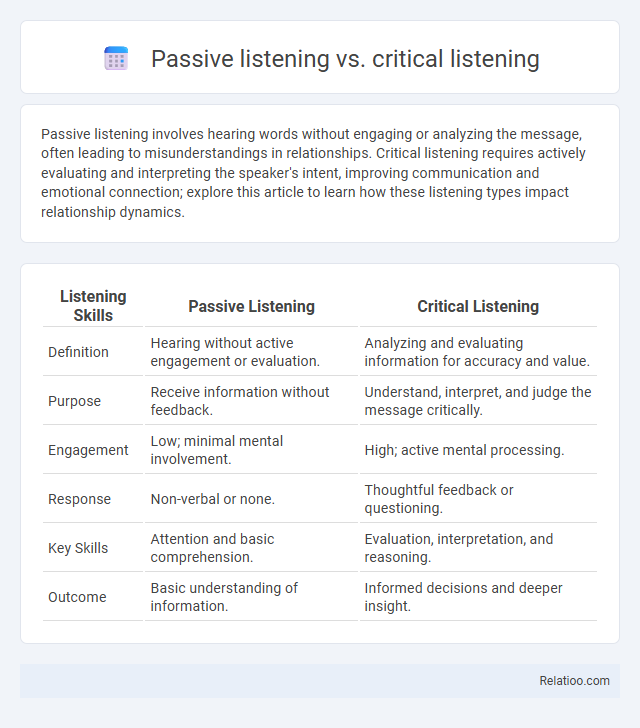Passive listening involves hearing words without engaging or analyzing the message, often leading to misunderstandings in relationships. Critical listening requires actively evaluating and interpreting the speaker's intent, improving communication and emotional connection; explore this article to learn how these listening types impact relationship dynamics.
Table of Comparison
| Listening Skills | Passive Listening | Critical Listening |
|---|---|---|
| Definition | Hearing without active engagement or evaluation. | Analyzing and evaluating information for accuracy and value. |
| Purpose | Receive information without feedback. | Understand, interpret, and judge the message critically. |
| Engagement | Low; minimal mental involvement. | High; active mental processing. |
| Response | Non-verbal or none. | Thoughtful feedback or questioning. |
| Key Skills | Attention and basic comprehension. | Evaluation, interpretation, and reasoning. |
| Outcome | Basic understanding of information. | Informed decisions and deeper insight. |
Introduction to Passive and Critical Listening
Passive listening involves hearing sounds without actively engaging or analyzing the information, often leading to minimal retention or understanding. Critical listening requires focused attention and evaluation of the message for logic, credibility, and relevance, enabling informed judgments and responses. Recognizing the differences between passive and critical listening enhances communication skills by fostering active comprehension and thoughtful analysis.
Defining Passive Listening
Passive listening involves hearing sounds without actively engaging or analyzing the information, often leading to minimal retention. Critical listening requires evaluating and interpreting the message to form judgments, while active listening demands full attention and interaction with the speaker. Understanding which type of listening you are using can improve your communication skills and information processing.
Understanding Critical Listening
Critical listening involves actively analyzing and evaluating the content, tone, and intent behind the message, making it essential for effective decision-making and problem-solving. Unlike passive listening, which merely involves hearing without engagement, critical listening requires your full attention and cognitive effort to identify biases, assumptions, and arguments. This skill enhances your ability to understand complex information and respond thoughtfully in conversations or presentations.
Key Differences Between Passive and Critical Listening
Passive listening involves hearing sounds without actively engaging or analyzing the content, often resulting in minimal retention or understanding. Critical listening requires focused attention to evaluate, interpret, and respond thoughtfully to the message, emphasizing comprehension and judgment. The key differences lie in the level of engagement and cognitive processing, with passive listening being automatic and superficial, whereas critical listening demands active participation and critical thinking skills.
Benefits of Critical Listening
Critical listening enhances comprehension by actively analyzing and evaluating the speaker's message, leading to better decision-making and problem-solving skills. Unlike passive listening, which involves minimal engagement, critical listening promotes deeper understanding and retention of information. This active process improves concentration and helps identify biases, inconsistencies, or hidden meanings within communication.
Drawbacks of Passive Listening
Passive listening involves hearing sounds without actively processing the information, which often leads to misunderstandings and missed important details in communication. Critical listening requires analyzing and evaluating the message, enabling better decision-making and problem-solving skills. Your comprehension and engagement suffer significantly with passive listening, limiting effective communication and knowledge retention.
Real-Life Examples of Listening Styles
Passive listening occurs when you hear sounds or words without engaging or analyzing the message, such as listening to background music while working. Critical listening demands attention and evaluation, like when you assess political speeches to identify biases or inconsistencies. Interactive listening involves actively responding and interacting, as seen in team meetings where you ask questions and provide feedback to ensure clear communication.
When to Apply Passive or Critical Listening
Passive listening is ideal when you want to absorb background information without intense focus, such as during casual conversations or ambient audio. Critical listening should be applied when analyzing complex arguments, evaluating ideas, or making decisions based on detailed information, like in academic settings or professional meetings. Your ability to distinguish when to switch between these listening modes enhances comprehension and effective communication.
Improving Your Critical Listening Skills
Improving your critical listening skills involves actively analyzing and evaluating the information you hear, unlike passive listening which requires minimal attention and critical thinking. Critical listening helps you discern biases, detect persuasive techniques, and assess the validity of arguments, enhancing decision-making and communication effectiveness. Developing this skill requires practice in focusing on content, questioning assumptions, and reflecting on the speaker's intent.
Conclusion: Enhancing Communication Through Better Listening
Effective communication relies on understanding the differences between passive, critical, and active listening, each serving unique purposes in interpreting messages. Enhancing Your listening skills involves shifting from passive hearing to critical evaluation and active engagement, fostering deeper comprehension and meaningful responses. Prioritizing these listening techniques improves interpersonal relationships and professional interactions by ensuring clarity, empathy, and thoughtful feedback.

Infographic: Passive listening vs Critical listening
 relatioo.com
relatioo.com